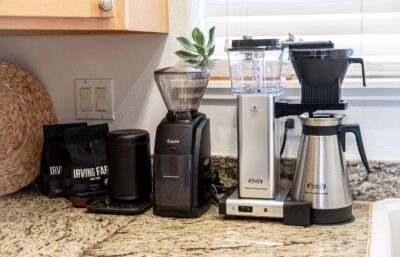5 Amazing Food Mill Substitutes That Brings Excellent Results
Who doesn’t love freshly puréed soups? Or mashed potatoes as a dessert? How about making your barbecue even yummier with thicker sauces? Hmm-mm! Any taste bud would get so excited about those!
Such recipes can only take a few minutes to complete with the help of a food mill.
What is a food mill?
A food mill is a kitchen tool that usually consists of a bottom plate with holes, a crank to crush or grind food, and a bowl. Its versatility in various preparation tasks such as puréeing and grinding food makes it one of the must-have kitchen tools. Moreover, a food mill can also separate any skin, seed, or core from certain foods such as potatoes, apples, and tomatoes.
Now, a food mill is a great kitchen tool and all, but what if you do not have that in your kitchen right now?
Does that stop you from getting the work done? Nope! Not a chance! Lucky for you, there are other alternative kitchen tools for the food mill that you might probably have somewhere in your kitchen.
Although you might need to take additional steps like seeding or peeling, rest assured that these alternatives shall produce similar results to that of a food mill.
1. Food Processor and Sieve

The combined power of a food processor and sieve can puree any food. Because of its fast pulsating motion and sharp blade, the food processor can bring you the similar texture that you can achieve with a food mill. On the other hand, the sieve will give you a puree that has an even texture due to its screening process from the food processor.
However, when using this alternative, you need to remove the skin and seeds from fruits and vegetables. You can use a fine-mesh strainer to remove the seeds and peel the skin before processing the food.
This duo requires electricity to work, so it is quite perfect for those who do not want to exert more energy and time in the mechanical machinery of the food mill by moving its lever back and forth.
Pros
- Flexible
- Time-saving and fast
- Easy handling
Cons
- Requires electricity
- Cannot produce a fine texture like that of a food mill
- Needs manual removal of peelings and seeds
2. Blender
If you do not have a food processor, then a blender might do the trick. Its pulse option can puree and mash food in no time. When grinding food, the blender is much faster than a regular food mill.

However, like the food processor and sieve duo, you will need to remove the seeds and skin of the vegetables and fruits first before putting them in the blender. A Peeler or knife should do the trick in no time. And if you have a much modern blender at your disposal, then using the highest speed option available can give you a fine liquid-like texture.
Pros
- Time-saving and very fast
- Requires minimal effort
- Can produce a fine texture, almost liquid-like form
- Easy handling
Cons
- Requires electricity
- Needs manual removal of peelings and seeds
3. Wooden Spoon and Strainer Duo
If you are the “exerting extra effort” individual and would rather choose to break a sweat doing manual labor in the kitchen, then this food mill alternative would be your pick.

Rather than moving a food mill’s lever back and forth that pushes the food in the mill to be ground and crushed, this alternative uses a wooden spoon to create yummy purees. The strainer primarily works as the food separator from the pureed and ensures that you get an even, uniform texture.
Let’s say, for example, you want to create a homemade tomato sauce version of yours. Use the wooden spoon and give the fresh tomatoes a big push down through the mesh strainer. Continue pressing and pushing until you achieve the texture you want. For a finer and creamier finish of your purees, you can choose a finer mesh strainer.
However, this alternative can take more time to finish than the other alternatives. Also, the texture heavily depends on your manner of pushing and pressing. This wooden spoon and strainer have only a few applications, and it is best for tomato sauce recipes.
Pros
- Depending on the degree of pressing, it can produce a fine texture
- Cheap
Cons
- Applicability is limited
- Exerts more energy and time
- Needs manual removal of peelings and seeds
- Cannot control texture
4. Hand mixer plus cheese Grater
Cheese grate is a great alternative to food mill when talking about softer foods like tomatoes and potatoes. The cheese grater works great in pureeing tomatoes and potatoes by scraping them into the coarse side of the grater. If you want a finer texture, a hand mixer or an electric mixer can do the job for you. But, you need to take extra care not to whisk or crush the ingredients too much to achieve a fluffier consistency.

However, for this to work effectively, you need to boil the ingredients first before grating. This would result in a softer and cheese-like texture when pureed.
Now, if you want this food mill alternative and consider buying a cheese grater, I would love to recommend buying a commercial-grade one. This is because such types are less likely to rust than others.
Pros
- Texture can be fined tuned
- Easy handling and operation
Cons
- Applicability is limited
- Exerts more energy and time
5. Potato Ricer
This food mill alternative is not only best in dealing potatoes, but it can also puree some of your favorite vegetables. What’s more amazing about this alternative is that its mechanism is quite simple.

First, you need to slice or cut your ingredients into smaller pieces. Then put them into the ricer hopper in small volumes. This is where you exert energy and press the ingredients using the handle to produce mashed food. Potato ricer can create fine and smoother purees if the ingredients are peeled during the processing.
Although its name has the word “potato”, potato ricer can also be of great use when mashing squash, tubers, and dense fruits such as apples. However, it does not do well with juicy foods like oranges and tomatoes. In general, this kitchen tool is a great substitute for mashing foods and is quite easy and very helpful for beginners in the kitchen and those who have a not-so-very-spacey kitchen.
Related: Best Potato Masher
Pros
- Manual operation
- Time-saving and very fast
- Space efficient
- Easy handling
Cons
- Cannot handle large volumes
- Applicability is limited
- Needs manual removal of peelings and seeds
Final Thoughts
Did you enjoy reading this article? What food mill substitute do you think would work best on your recipes?
Having no food mill will never be a problem anymore since different alternative tools substitute in processing ingredients like the ones mentioned above. While there are many other substitutes for food mills out there, the five listed alternatives in our article have already proven their worth in many kitchens across the world. Give them a try! And you’ll be amazed.
If you have any inquiries or ideas for other awesome food mill substitutes, you can share them with us through the comment section. And please don’t forget to share this with your family and friends to pass the information to them.